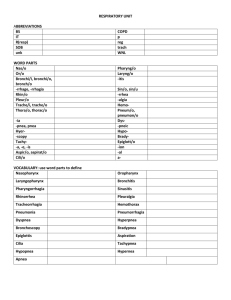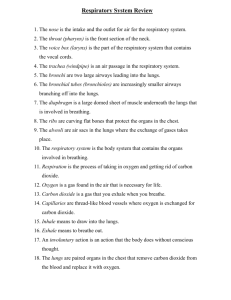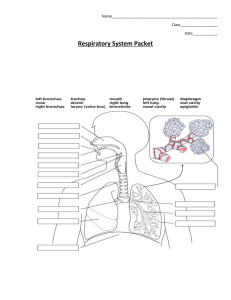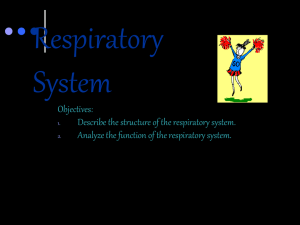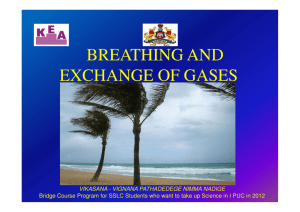Respiratory System Investigation Name What are the organs of the
advertisement
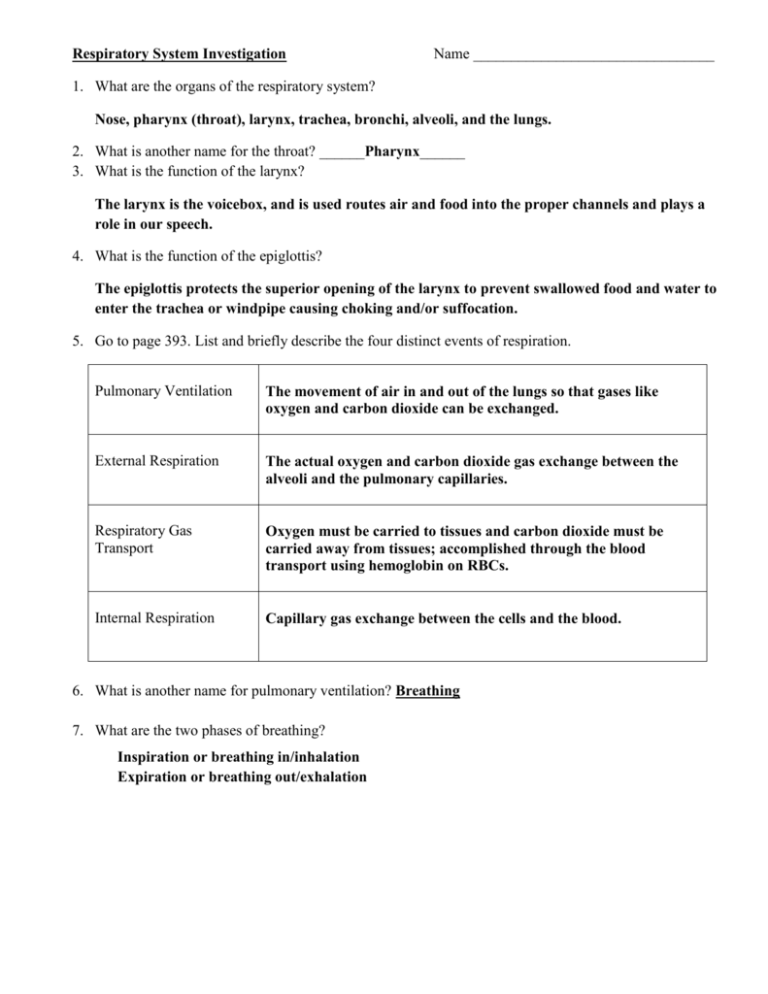
Respiratory System Investigation Name ________________________________ 1. What are the organs of the respiratory system? Nose, pharynx (throat), larynx, trachea, bronchi, alveoli, and the lungs. 2. What is another name for the throat? ______Pharynx______ 3. What is the function of the larynx? The larynx is the voicebox, and is used routes air and food into the proper channels and plays a role in our speech. 4. What is the function of the epiglottis? The epiglottis protects the superior opening of the larynx to prevent swallowed food and water to enter the trachea or windpipe causing choking and/or suffocation. 5. Go to page 393. List and briefly describe the four distinct events of respiration. Pulmonary Ventilation The movement of air in and out of the lungs so that gases like oxygen and carbon dioxide can be exchanged. External Respiration The actual oxygen and carbon dioxide gas exchange between the alveoli and the pulmonary capillaries. Respiratory Gas Transport Oxygen must be carried to tissues and carbon dioxide must be carried away from tissues; accomplished through the blood transport using hemoglobin on RBCs. Internal Respiration Capillary gas exchange between the cells and the blood. 6. What is another name for pulmonary ventilation? Breathing 7. What are the two phases of breathing? Inspiration or breathing in/inhalation Expiration or breathing out/exhalation 8. What is happening in each of the two phases? What happens to the respiratory muscles (diaphragm and external intercostals)? What happens to pressure inside the lungs? Phase Breathing in or Breathing out What happens to respiratory muscles? What happens to pressure inside lungs? Breathing In The respiratory muscles contract and the thoracic cavity increases in size The air pressure inside the lungs decreasing thus forcing air to enter the lungs Breathing out The respiratory muscles relax causing the thoracic cavity to decrease in size The air pressure inside the lungs increases forcing air out of the lungs into the environment. Inspiration Expiration 9. What are some of the things that affect a person’s respiratory capacity? Smoking, diseases like asthma or pneumonia, exercise, a person’s age, a person’s gender, a person’s size, and a person’s physical condition. 10. What is tidal volume? How much air is being moved with this? Tidal volume is the respiratory volume from normal quiet breathing in and out of the lungs with each breath; usually 500 mL of air with each breath. 11. What is IRV or Inspiratory Reserve Volume? How much air is being moved? IRV is the amount of air that can be taken in forcibly over the tidal volume. Normally, the IRV is between 2100 and 3200 mL of air. 12. What is ERV or Expiratory Reserve Volume? How much air is being moved? ERV is the amount of air that can be forcibly exhaled after a tidal expiration. Usually this volume is approx. 1200 mL of air. 13. What is residual volume? Why is this important to human health? Residual volume is the amount of air the remains in the lungs despite every effort to exhale it. It cannot be voluntarily expelled. It is important because it allows gas exchange to go on continuously even between breaths and helps to keep the alveoli inflated/open. 14. Explain in your own words what vital capacity is. The book provides an equation for calculating a person’s vital capacity. What is the equation? Vital capacity refers to the amount of air that needs to be maintained in order to remain healthy and at homeostasis. It is the total amount of exchangeable air that a person requires to survive. The equation is Tidal volume (TV) + Inspiratory Reserve Volume (IRV) + Expiratory Reserve Volume (ERV) = Vital Capacity or VC. 15. What is a spirometer and what does it measure? A spirometer is an instrument that measures respiratory capacities. 16. What is external respiration? External respiration is the actual gas exchange (oxygen and carbon dioxide) between the alveoli and the blood (capillaries of the lungs). 17. Why would a physician be concerned with external respiration for patient #4? Because they suspect sickle cell anemia which already puts them at a high risk for low blood levels of oxygen. They would want to ensure that the patient is breathing normally to prevent a further decrease in oxygenation. 18. What molecule is affected by the sickle cell gene? What affect does this have on oxygen saturation in the blood? Hemoglobin. It mutates the shape of hemoglobin which then distorts the shape of the red blood cell. This results in reduced amounts of oxygenation of blood and tissues. 19. Go to page 403. What is COPD stand for? What is it? What are four common things that patient’s with COPD experience? COPD stands for Chronic Obstructive Pulmonary Disease. It is a disabling respiratory disorder that results in reduced oxygenation of blood and shortness of breath. The four common things are 1) they are usually smokers 2) experience dyspnea or difficult/labored breathing 3) coughing and frequent pulmonary infections 4) hypoxia where they retain carbon dioxide and have lower oxygen levels in blood. 20. What is dyspnea? Difficult or labored breathing 21. What is emphysema and what happens to a patient with emphysema? The alveoli enlarge as the walls of adjacent chambers break through, which can lead to chronic inflammation and fibrosis of the lungs. The lungs become less elastic and can collapse while expiring air and needs considerable effort to breath out air. This causes higher air retention in lungs which leads to barrel chests. 22. Are any of your patient’s smokers? Which ones? Yes, patient #3 has said he smokes a pack a day. 23. Which of your four patients might experience some respiratory distress over the course of their conditions? Explain why and justify your position with data from your medical condition investigations from the first day. Patient #4 because we are suspecting that he might be suffering from sickle cell anemia which leads to reduced oxygenation because of faulty hemoglobin. Also, he has complained of shortness of breath after performances and he has experience fatigue most likely due to reduced oxygenation of blood.




